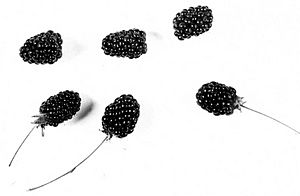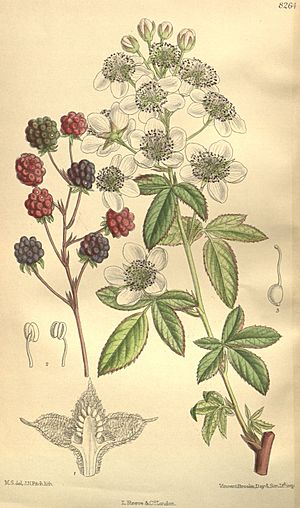Smooth blackberry facts for kids
Quick facts for kids Smooth blackberry |
|
|---|---|
 |
|
 |
|
| 1909 Fitch illustration | |
| Conservation status | |
| Scientific classification | |
| Genus: |
Rubus
|
| Species: |
canadensis
|
Rubus canadensis is a type of flowering plant in the rose family. You might know it by its common names like smooth blackberry, Canadian blackberry, or thornless blackberry. This plant grows naturally in central and eastern Canada, from Newfoundland to Ontario. It's also found in the eastern United States, including New England, the Great Lakes region, and the Appalachian Mountains.
Contents
What is the Smooth Blackberry?
The smooth blackberry is a type of shrub that can grow quite tall, usually between 2 to 3 meters (about 7 to 10 feet). It often forms thick patches. Its leaves fall off in the autumn, just like many trees. These leaves are arranged one after another along the stem. Each leaf can be pretty big, about 10 to 20 centimeters (4 to 8 inches) long.
Flowers and Fruit
This plant produces clusters of up to 25 flowers. After the flowers bloom, they turn into fruit. The fruit is a blackberry, which is actually made up of many tiny little fruits called drupes all stuck together. Each tiny drupe has a small seed inside.
How the Plant Grows and Spreads
The smooth blackberry can spread in a few ways. It can grow from seeds, which are inside the fruit. It can also sprout new plants from its underground stems, called rhizomes. Another way it spreads is by a process called layering. This happens when a stem touches the ground and starts to grow roots, forming a new plant. Its stems can grow very quickly, sometimes reaching one meter (about 40 inches) in height in less than two months!
Where Does the Smooth Blackberry Live?
Rubus canadensis likes to grow in many different kinds of forests. You can also find it in places where the land has been disturbed, like along roadsides or in clearings.
Plant Neighbors
Many other plants often grow near the smooth blackberry. Some of its plant neighbors include:
- Mountain maple
- Serviceberry
- Hobblebush
- Scarlet elder
- Common blackberry
- Beaked hazel
- Southern mountain cranberry
- Minnie-bush
- Rosebay
Animals and People Use This Plant
Many different animals enjoy eating the fruits and leaves of the smooth blackberry. The thick patches of these plants also provide great places for animals to hide and build their nests.
Long ago, Native American groups used the fruits of this plant as food. They also sometimes used different parts of the plant for traditional medicines.


